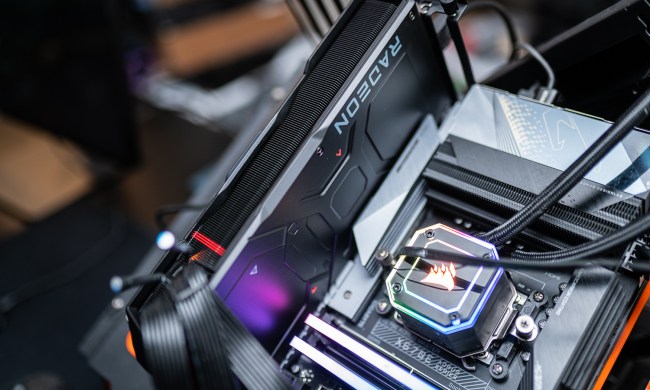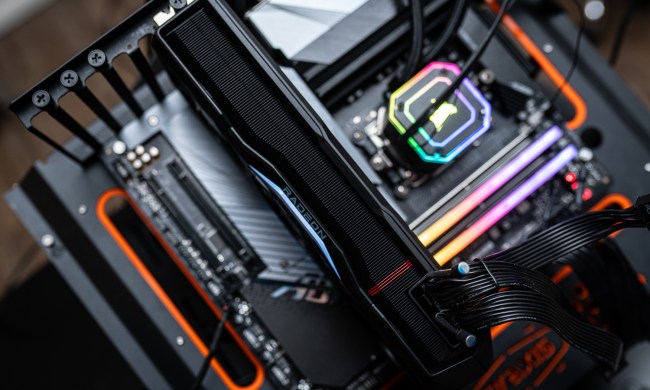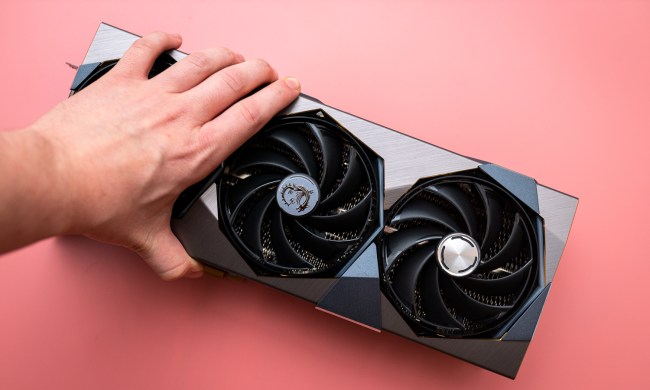Nvidia’s recent release of new RTX 2080 and RTX 2080 Ti video cards once again left AMD without a card that can respond to the green team’s most extravagant hardware. The Radeon RX Vega 64, AMD’s previous top-tier, was a GTX 1080 competitor at best, with little hope of keeping up with the new RTX 2080.
AMD’s response has arrived, just a few months after the RTX 2080’s September launch. It’s aimed directly at the card in both specifications and price. The Radeon VII will hit store shelves with an MSRP of $699. While the RTX 2080 Founder’s Edition was priced at $799, standard versions of the card start at $699, too.
AMD’s cards have often undercut Nvidia to excuse mediocre performance, but there’s no apologetic pricing here. The Radeon VII is designed to wrestle with Nvidia’s RTX 2080. Can it pull off a victory?

It’s all about that HBM
The Radeon VII is an example of the differences in AMD and Nvidia’s strategy. The green team has put its faith in ray tracing. AMD, meanwhile, is taking a more traditional route, cutting chip size while slamming in gobs of memory.
I’ll start first with the first: The Radeon VII is the world’s only 7-nanometer gaming GPU. Nvidia’s cards are built on a 12-nanometer node. That shrinks the Radeon VII’s chip to 331 square millimeters. That’s down from the 495mm² chip found in the Radeon RX Vega 64 and much smaller than the 545mm² chip in Nvidia’s RTX 2080.
Powered by a second-generation iteration of the Vega architecture, the Radeon VII has a base clock of 1,400MHz, and a boost clock of 1,750MHz. That’s over 200MHz higher than the Radeon RX Vega 64’s boost clock.
Stuffing this much memory into a video card may seem absurd, but AMD considers it essential.
The real story, though, is in the memory. AMD debuted its new High Bandwidth Memory with the Vega 64 and 54, adding 8GB to both. That was a lot, but the Radeon VII doubles that to an insane 16GB. It also more than doubles the memory bandwidth, which now hits a terabyte per second. These figures leap past the Nvidia RTX 2080 and exceed the RTX 2080 Ti, which quotes 11GB of GDDR6 memory with bandwidth up to 616 gigabytes per second.
Stuffing this much memory into a video card may seem absurd, but AMD considers it essential. The company’s strategy is focused on eliminating bandwidth bottlenecks. AMD thinks that’s an issue as gamers begin to embrace 4K.
Despite its advanced 7nm production node, the Radeon VII quotes 300 watts of power consumption. That’s up from Vega 64’s 290 watts, and far more than the RTX 2080 Founder Edition’s 225 watts. I doubt the added consumption matters to most gamers, but it does mean the RTX 2080 can get by with a 6pin+8pin PCI power connection, while the AMD Radeon VII requires dual 8-pin connections.

The Radeon VII supports HDR and up to 8K resolution. It does not, however, support ray tracing. That’s exclusive to Nvidia for now. AMD’s CEO, Dr. Lisa Su, said at CES 2019 that the company is “deep in development” of ray tracing hardware but doesn’t want to debut it until “the customer is going to see [the benefit.]”
I have no problem with AMD’s stance. Ray tracing looks great in Battlefield V, but that showcase is the only real use for the feature right now (for western gamers, at least). Metro Exodus is the next big game to promise ray tracing support. A patch is coming Shadow of the Tomb Raider but lacks a release date. That’s not much in terms of developer support.
Excellent gaming performance
Game performance is what matters, and it’s where we’ll see if AMD’s big bet on memory bandwidth pays off. I started testing with 3DMark, a gaming benchmark that provides a summary of how video cards stack up.
That’s a pretty picture for AMD, isn’t it? The Radeon VII beats the Nvidia RTX 2080 Ti in the Fire Strike benchmark, and it easily defeats the Nvidia RTX 2080. That’s a clear win right out of the gate. There’s also reason to be skeptical, though, because 3DMark puts the Radeon RX Vega 64 just behind the RTX 2080. I know from experience that’s not a great indicator of how the two cards compare in real games.
There’s nothing for it, then. Let’s jump into the real-world gameplay tests. These were all conducted on a desktop system with a Ryzen Threadripper 1950X processor (in Game Mode) and 32GB of DDR4 2,400MHz RAM.
First up? 1080p, the most popular resolution in all of PC gaming.
These cards are overkill for most 1080p monitors, but gamers who own a high-refresh 144Hz monitor may consider the Radeon VII or RTX 2080 if they want to use their display to its full potential. My tests make it clear those players would be better served by the Radeon VII.
AMD’s new card doesn’t just outpace the RTX 2080. It keeps up with the more expensive RTX 2080 Ti across all three games we tested. The Radeon VII’s greatest victory comes in Battlefield V, where it hit an average of 115 FPS at 1080p and Ultra detail. That’s 10 FPS better than the RTX 2080 Ti.
It’s an interesting result. AMD’s memory-heavy design is meant to help at high resolutions, but what we see here suggests the Radeon VII has some secret sauce at 1080p, too.
Of course, most 1080p gamers will choose a less expensive card. Flagships like the Radeon VII start to shine at 1440p.
The story starts to shift at this resolution. Now the Radeon VII is behind the RTX 2080 Ti in Battlefield V, and it no longer ties the RTX 2080 TI in Deus Ex: Mankind Divided. Strangely, AMD’s card seems to have less of an edge here than it did at a lower resolution.
Yet, it hardly matters. The Radeon VII still puts the RTX 2080, its direct competitor, on notice. AMD wins an easy victory in Deus Ex, beating its Nvidia peer by 24 FPS. Battlefield V halves the margin of victory to 12 FPS, but that’s still a solid win. Civilization VI, the most CPU-heavy of our test games, still sees all the cards in a dead heat as they bump against the limits of our test rig’s Threadripper 1950X processor.
I think AMD’s win at this resolution is the most significant result of all my testing. 1440p is really where these cards are most comfortable, as they can deliver stunning detail while hitting at least 60 FPS, even in the most demanding titles. Still, some players might want to push to 4K resolution. Here’s what happens if you do.
Upping the resolution to 4K predictably lowers performance across all cards, but I don’t think the overall story shifts much from 1440p. The Radeon VII’s results land directly between the RTX 2080 and the RTX 2080 Ti. The wins now look smaller, as all the cards struggle to cope with more than eight million pixels, but they remain significant.
I could tell the difference between the Radeon VII and the RTX 2080 in Deus Ex: Mankind Divided. AMD’s card not only achieved a better average framerate, it never dipped below 30 FPS — a critical mark. The Radeon VII’s minimum measured framerate was 32.4 FPS, while the RTX 2080 bottomed out at 26.5 FPS.
AMD’s Radeon VII wins an upset victory
I didn’t expect the AMD Radeon VII to impress me. The older Radeon RX Vega 56 and 64 were great cards on paper, but just okay in benchmarks. I doubted AMD’s follow-up would be different.
Consider me a convert. Nvidia’s grand ray tracing adventure has given AMD a chance to define itself with a more traditional card that turns all the dials up to 11. The Radeon VII doesn’t just best the RTX 2080. It sometimes keeps pace with the RTX 2080 Ti, a video card that’s priced at $1,199.
That’s even more important than it sounds. Technically, the RTX 2080 Ti is the fastest video card built for gamers, but at $1,199, its priced way beyond what most gamers are able (or willing) to afford. The $500 to $750 is where I think ‘true’ flagships are found, and in that arena, AMD’s new Radeon VII emerges the victor.
It’s simple. AMD’s Radeon VII is the flagship video card you should buy.







